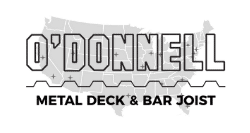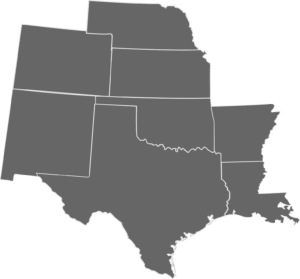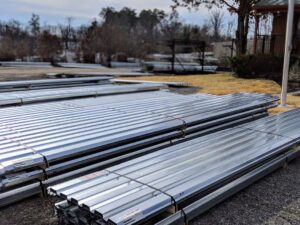
When it comes to metal decking for your project, selecting the right type is essential for both immediate and long-term project success. There are several profiles, sizes and finishes to choose from, all of which have different characteristics and benefits.
Here at O’Donnell Metal Deck, we offer superior quality products and profile options for roofing, steel form deck and composite metal deck. In this article, we will explore our metal deck offerings in detail and what profiles and sizes can help you on your next metal deck project.
Overview of Metal Deck
When it comes to structural support, steel decking is the recommended product for your commercial construction projects. Whether you need floor or roof decking, choosing the right metal decking profile for your project can be difficult and complex.
Metal decking is made to support both dead loads and live loads.
Live Load: Live load refers to any weight that is not part of the permanent or fixed structure. On a roof or concrete slab, this could include the weight of people walking on it, equipment or materials that are temporarily placed on it or any other objects that are not part of the structure supported by the metal deck.
Dead Load: Dead load refers to the weight of the structure itself, as well as any permanent fixtures or materials that are part of the structure.
Types of Metal Deck
When it comes to metal decking, three primary types are commonly used in commercial construction projects. These include:
- Metal Roof Deck
Steel Form Deck
Composite Metal Deck
Metal Roof Deck Profiles, Sizes and Finishes
A steel roof deck provides the necessary platform for insulation, weatherproofing and acts as a working platform during construction to complete other components of your roof. Metal roofing decking is not designed or meant to be used as a watertight or under any circumstance a finished roof assembly. Instead, metal decking serves as the foundation that provides structural support by bolstering your finished commercial roof assembly.
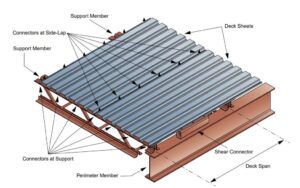
Available Finishes
When it comes to the types of metal deck finishes, the following are the most popular:
G-60: G-60 Galvanized Zinc Coated Steel is the industry standard for corrosion resistance in a metal deck.
G-90: Galvanized G-90 is a commonly demanded finish for outdoor projects with specific requirements.
PTD: PTD or primer painted is a temporary, provisional coating with a grey top finish and a grey or white bottom finish.
GALV & PTD: Another popular finish option is the galvanized base coil with a special baked on enamel primer paint. This is available in a grey top finish and grey or white bottom finish.
Profiles and Sizes
1.5-inch Type B
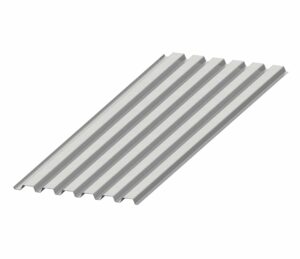
1.5-inch deep Type B Roof Deck, also known as wide rib deck, offers a solid foundation for various roof coverings and allows for more insulation to be installed compared to other metal structural decks due to its wider rib profile.
The profile of a Type B metal roof deck panel is 36 inches wide with square top corrugations that are 2.5 inches apart and 6 inches on center. It is available in 16, 18, 20 and 22 gauge with G-60, G-90 and PTD finishes.
3-inch Type N
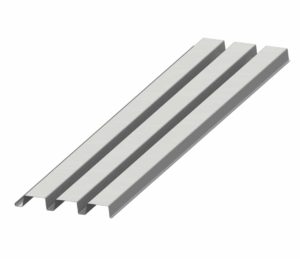
Type N Roof Deck stands 3 inches deep and is referred to as “deep rib.” This metal roof deck provides a strong foundation for multiple types of roof coverings, with the extra-wide ribs granting it an extended span between its supporting elements.
Type N roof deck is sold in 24-inch wide sheets with square top corrugations that are 3 inches apart and 8 inches on center. It is available in 18, 20 and 22 gauge with G-60, G-90 and PTD finishes.
Steel Form Deck Profiles, Sizes and Finishes
Steel form deck is the perfect solution for those looking to save time and energy in concrete floor slab construction. Not only does it eliminate temporary wood forming, but its efficient design can also remove the need for shoring during the building process.

Steel pans provide lateral stability but do not engage with the slab. Form deck can be used in a variety of ways but is used primarily in stairways, foundations, and shallow mezzanine designs.
Available Finishes:
G-60: The G-60 Galvanized Zinc Coated Steel is the industry standard for corrosion resistance in metal decking.
G-90: Galvanized G-90 is a commonly demanded finish for outdoor projects with specific requirements.
It can also be ordered unfinished.
Profiles and Sizes
9/16-inch Steel Form Deck
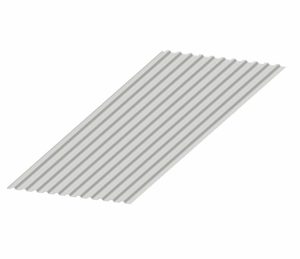
A 9/16-inch form deck panel is the perfect choice for small spans and residential projects as it requires less concrete than deeper forms, yet still offers strength and stability. The lightweight design makes it easier to use in tight spaces without sacrificing any of its durability.
It is available in 35 and 36-inch widths with square top corrugations that are 2.5-inches on center. This deck panel is manufactured in 18, 20, 22, 24, 26 and 28 gauge material.
1-inch Steel Form Deck
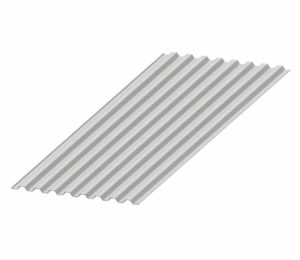
1-inch steel form deck offers a variety of applications. To ensure optimal performance, pour at least 2 inches of concrete on top for an overall slab thickness of 3 inches.
It can be purchased in 36-inch widths. These panels have square top corrugations that are 4.5 inches on center and are available in 18-28 gauge.
Composite Metal Deck Profiles, Sizes and Finishes
Steel composite deck panels are often referred to as “floor deck” due to the presence of steel embossments. These repeating indentations in the flutes of the deck profile create a composite action between metal and concrete that interlocks them together securely. Embossment is an essential feature of composite steel decking when poured with concrete, making it immediately distinguishable from other types of structures.
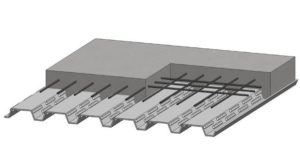
Available Finishes:
G-60: The G-60 Galvanized Zinc Coated Steel is the industry standard for corrosion resistance in the deck.
G-90: Galvanized G-90 is a commonly demanded finish for outdoor projects with specific requirements.
PTD: PTD or primer painted is a temporary, provisional coating that has a gray hue on both sides.
Profiles and Sizes
1.5-inch Composite Steel Deck
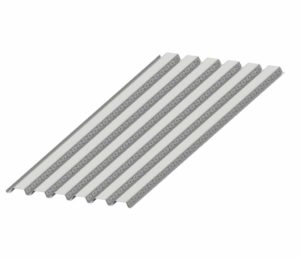
1.5-inch composite metal deck is an efficient choice for short spans, as it requires less concrete than a deeper composite deck. To achieve the optimal slab thickness of 3.5 inches, a minimum of 2 inches of concrete should be poured over the ribs of the deck.
The pans are 36 inches wide with square top corrugations that are 2.5 inches from shoulder to shoulder and spaced 6 inches on center. The 1.5-inch panels are made in 16-22 gauge steel.
2-inch Composite Steel Deck
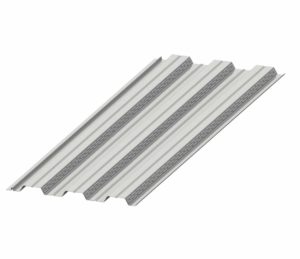
2-inch composite metal deck is ideal for projects with large spans, as the 2-inch deep rib can accommodate additional reinforcement such as rebar or wire mesh. To maximize strength and stability, it’s recommended to pour at least a 2-inch layer of concrete atop the ribs in order to achieve an overall slab thickness of 4 inches.
The steel pans are 36 inches wide, with square top corrugations that are 7 inches from shoulder to shoulder and spaced 12 inches center to center. They are manufactured in 16, 18, 20 and 22 gauge steel.
3-inch Composite Steel Deck
For longer spanning capabilities, the 3-inch composite metal deck is the preferable option. However, it requires more concrete than shallower options. To ensure proper load distribution and strength of your slab, it’s advised to pour a minimum of 2 inches of concrete over its ribs for a total thickness of 5 inches.
The pans are 36 inches wide, with square top corrugations that are 7 inches from shoulder to shoulder and spaced 12 inches on center. The 3-inch composite deck is available in 16-22 gauge steel.
Your Trusted Metal Deck Supplier For 35+ Years
Knowing all the details of metal roof deck construction, we supply steel roof decking and metal decking for concrete for all types of projects. At O’Donnell Metal Deck, we are more than another average metal deck supplier. For over 35 years, we have dedicated ourselves to providing the best metal deck products and accessories with fast delivery service nationwide.
Regardless of whether you are a private business, contractor or government agency seeking information on the right metal deck for your project, our specialists can provide unparalleled product knowledge and continued assistance through every stage until completion.
Contact us today and let us assist you with your next project!
